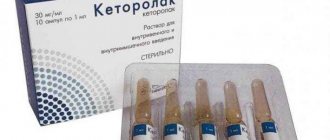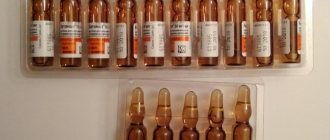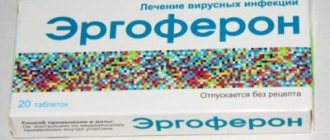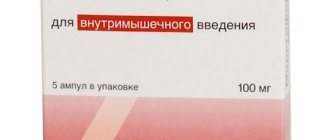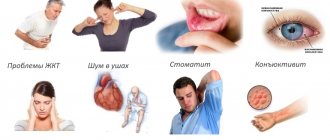Composition of the drug Ketorol
The active substance in tablet form is ketorolac tromethamine, and the main auxiliary elements are: lactose, microcrystalline cellulose, corn starch.
The solution in ampoules is also based on ketorolac. But the excipients here are different: sodium chloride, ethyl alcohol, propylene glycol and octoxynol. About 1 ml is purified water for injection.
Gel for external use relieves pain thanks to the same main substance that is used in other dosage forms - ketorolac. Additional elements in the composition are: dimethyl sulfoxide, sodium methyl parahydroxybenzoate, carbomer, tromethamine and water.
Interaction
Drug interactions for Ketorol solution and tablets
The use of ketorolac in combination with other NSAIDs, ASA ( acetylsalicylic acid ), ethanol, calcium preparations, corticotropin and corticosteroids can lead to ulceration of the gastrointestinal mucosa and the development of bleeding from ulcerative defects.
Co-administration with Methotrexate increases hepato- and nephrotoxicity, and with Paracetamol - nephrotoxicity. With Methotrexate, ketorolac can be prescribed only if Methotrexate is used in the lowest possible dose (in this case, plasma concentrations of methotrexate ).
Probenecid reduces the volume of distribution and plasma clearance of ketorolac , increases its plasma concentration and increases the half-life. With the use of ketorolac, Methotrexate may decrease , and the toxicity of these substances may increase.
Use in combination with indirect anticoagulants and drugs for thrombolytic therapy , Heparin , cephalosporin antibiotics , antiplatelet agents increases the risk of bleeding.
Ketorolac , acting as an inhibitor of Pg synthesis in the kidneys, reduces the effect of diuretics and antihypertensive drugs .
In the case of simultaneous use with narcotic painkillers, the doses of the latter may be significantly lower.
Antacids do not alter the absorption of ketorolac .
Increases the hypoglycemic effect of oral antidiabetic agents and insulin , which requires dose recalculation.
Combined use with valproic acid provokes a violation of platelet aggregation.
Increases plasma concentrations of Nifedipine and Verapamil .
When combined with other nephrotoxic drugs (for example, with Au preparations), the likelihood of nephrotoxic effects increases.
Drugs that block tubular secretion reduce clearance and increase plasma concentrations of ketorolac .
Drug interactions with topical use of ketorolac
The possibility of pharmacokinetic interaction with drugs competing for binding to plasma proteins cannot be ruled out.
The gel should be used with caution in combination with Phenytoin , other NSAIDs, diuretics , Digoxin , Cyclosporine , Li drugs, Methotrexate , antidiabetic and antihypertensive drugs .
Patients using any of the listed drugs should begin treatment with Ketorol only with the approval of a physician.
Pharmacological group
Ketorol belongs to the group of non-steroidal anti-inflammatory drugs, which includes many drugs of different compositions, differing in their mechanisms of action, but with similar pharmacological effects. The main difference between this group is the lack of effect on the adrenal glands, that is, this group of medications is not hormonal.
There are three main areas in which non-steroidal anti-inflammatory drugs act:
- relieving pain;
- relieving inflammation;
- normalization of body temperature.
Ketorol, being a representative of NVPS, performs all three functions.
Indications
Toothache is an indication for the use of the drug.
"Ketorol" is indicated for use for pain of various etiologies (muscular, joint, dental). The medicine helps with neuralgia, myalgia, cancer diseases and all kinds of injuries. With the help of the described pharmaceutical drug it will be possible to eliminate severe pain from burns, as well as alleviate the condition of women during painful menstruation. It is advisable to use the medication when the ear hurts due to an inflammatory process in it and to relieve pain in pathologies of the musculoskeletal system.
When is Ketorol prescribed?
Three main directions of the drug form the indications that become the reason for prescribing Ketorol:
- soft tissue bruises;
- bursitis;
- ligament damage;
- synovitis;
- myalgia of any etiology;
- neuralgia;
- radiculitis;
- rheumatism.
It should be remembered that taking Ketorol is predominantly symptomatic. When pain appears from the list of indications, take the drug. If there is no pain, you do not need to drink Ketorol or use it as a course of injections.
The choice between tablets and injections is made after analyzing several factors:
- if you have stomach diseases, the tablets are contraindicated;
- for persistent vomiting or difficulty swallowing, Ketorol is administered intramuscularly;
- a broken jaw is a reason to make a choice not in favor of pills;
- acute pain from radiculitis is relieved faster after injection;
- menstrual pain is relieved after taking Ketorol tablets;
- in the postoperative period, they also often opt for tablets, especially if intramuscular administration is complicated by the consequences of the operation.
Despite the fact that Ketorol is prescribed as a NSAID, the main indication is pain. When body temperature rises, preference is given to other active ingredients.
Manifestations of overdose and its elimination
If the overdose was severe, then the body succumbs to severe intoxication, which manifests itself in the form of symptoms such as:
- stomach ache;
- vomiting and nausea;
- dizziness;
- bleeding in the gastrointestinal tract;
- muscle spasms and cramps;
- apathy;
- speech problems;
- problems with brain activity;
- pressure reduction;
- sweating and coldness in the extremities.
In case of overdose, you need to take the following measures:
- remove the remaining tablets from the internal organs when no more than an hour has passed after taking them by inducing a gag reflex;
- we reduce the concentration of toxins using sorbents (activated carbon, Enterosgel, Sorbex, etc.);
- Provide the patient with water-salt balance - you need to drink at least 2 liters in small sips, but infrequently. For best results, make a saline solution based on salt and soda and sugar. The mixture should be drunk for several days until the side effects completely disappear.
An overdose can occur even with the usual dose of Ketorol when combined with other non-steroidal drugs or together with intramuscular injections . Be sure to read the instructions and follow the dosage.
Contraindications
Any non-steroidal drugs, including Ketorol, are not prescribed for lesions of the gastrointestinal tract. This is due to the fact that NSAIDs increase the risk of gastric bleeding, especially in people aged 60+.
Other contraindications include:
- bronchial asthma;
- renal failure;
- lactation;
- pregnancy;
- hyperkalemia;
- patient age under 16 years;
- liver diseases;
- cerebral hemorrhage.
In addition, simultaneous use with the following drugs is prohibited:
- pentoxifylline;
- acetylsalicylic acid;
- lithium salts;
- probenecid;
- anticoagulants.
Take Ketorol with caution in case of thyroid diseases, diabetes mellitus and severe somatic diseases.
special instructions
Before prescribing the drug, it is necessary to find out whether the patient has previously had allergic reactions to Ketorol or NSAIDs. Due to the risk of allergic reactions, the first dose should be administered under close medical supervision.
Hypovolemia increases the risk of developing nephrotoxic adverse reactions.
If necessary, the drug can be used in combination with narcotic analgesics.
Ketorol is not recommended for use as a drug for premedication or maintenance of anesthesia during major surgical interventions.
When used simultaneously with other NSAIDs, cardiac decompensation, fluid retention, and increased blood pressure may occur. The effect on platelet aggregation ceases after 1-2 days.
The drug can change the properties of platelets, but does not replace the preventive effect of acetylsalicylic acid in cardiovascular diseases.
In case of blood clotting disorders, the drug is prescribed only with constant monitoring of the platelet count. It is especially important for postoperative patients who require careful monitoring of hemostasis.
The risk of developing drug complications increases with increasing doses of the drug (more than 90 mg per day) and lengthening therapy.
To reduce the risk of developing NSAID gastropathy, omeprazole, misoprostol, and antacid medications are prescribed.
The gel should be applied only to intact areas of the skin and avoid contact with open wounds, eyes and mucous membranes. Do not apply airtight dressings over the drug. After applying the gel, you must wash your hands thoroughly with soap. The tube should be tightly closed after each use.
During therapy, patients should be careful when conducting potentially hazardous activities that require increased attention and speed of psychomotor reactions.
How to take Ketorol
Regarding the oral form, two schemes are used, differing in the type of tablets:
- for resorption;
- To be swallowed with water.
Lozenges contain 10 mg of active substance. If moderate pain occurs, place 1 tablet on the tongue until it is completely dissolved. No need to drink water. If the pain returns after a while, you can repeat the dose. The maximum daily dose is 4 tablets (40 mg ketorolac).
Tablets, intended to be swallowed with water, contain 10 mg of ketorolac. Daily intake should not exceed 40 mg of the drug. Adults can take Ketorol tablets every 4-6 hours. For elderly patients aged 60+, it is necessary to increase the interval between doses to 6-8 hours.
Injections for intramuscular administration can be repeated no more often than after 4 hours. The first analgesic effect is noted within half an hour after administration of the solution. The maximum analgesic effect occurs after 1.5 hours.
Reviews of Ketorol
Reviews of Ketorol tablets, as well as reviews of injections and gel, are positive in 95-98% of cases. Ketorol helps with toothache, back and muscle pain, and headaches within half an hour, and its effect lasts up to six hours.
Most patients note that when using the medicine in accordance with the instructions, side effects occur extremely rarely. Sometimes the disadvantages of Ketorol are a large number of contraindications and the impossibility of long-term use.
Read also[edit | edit code]
- Anestezin
- Apizartron
- Arnica
- Ben gay
- Butadion
- Venoruton
- Viprosal
- Virapin
- Voltaren
- Heparinoids
- Heparin ointment
- Hepatrombin
- Diclofenac
- Dimexide
- Ibuprofen
- Indovazin
- Iruksol
- Lyoton gel
- Menthol
- Formic alcohol
- Nicoflex
- Nimesulide
- Novocaine
- Panthenol
- Piroxicam
- Plantain
- Propolis
- Bee venom
- Rosemary oil
- Chamomile
- Troxevasin
- Fastum gel
- Flexen
- Fluorocort
- Chloroethyl
- Zinc paste
- Series
- Celandine
- Efkamon

